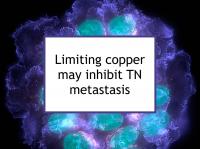While copper is a vital nutrient required for iron metabolism and blood cell formation, high levels of copper in the blood have been linked to increased breast cancer risk. Tissue concentrations of copper can be greatly elevated in breast cancer. Copper has been shown to promote angiogenesis and have a role in breast cancer cell migration and invasion.
Inducing copper deficiency have been shown to reduce tumor growth and angiogenesis in mouse models of HER2-positive (HER2+), triple negative (ER-/PR-/HER2-) and inflammatory breast cancer (IBC). In addition, reducing copper levels in breast cancer patients at high risk for recurrence has been reported to promote tumor dormancy and help prevent relapse. Now a new study has described how copper chelation (i.e., using a drug to remove copper from the body) reduces metastasis of highly aggressive triple negative breast cancer cells.
Food sources of copper
The following foods have especially high concentrations of copper:
Calf's liver contains 12 to 15 mg of copper per 100 g (3.5 oz.), which is well above the recommended dietary allowance (RDA) of 0.9 mg per day. On the other hand, the copper content of chicken liver is about 0.5 mg per 100 g. The foods below contain far less copper than calf's liver, but are potentially significant sources if consumed frequently:
- Basil pesto
- Beef
- Chocolate & cocoa powder
- Flaxseed
- Lentils
- Lima beans
- Nuts, including almonds, Brazil nuts, cashews, hazelnuts, peanuts, pecans, pine nuts, pistachio nuts, walnuts
- Pumpkin seeds
- Sesame seeds
- Shellfish, especially oysters, squid (calamari) & lobster
- Soybeans
- Defatted soy flour products, e.g., soy protein isolate, textured soy protein
- Sun-dried tomatoes
- Sunflower seeds
Most nuts are a significant source of copper. However, walnuts have significant chemopreventive properties and should be consumed in moderation rather than avoided because of their copper content. Note that curcumin, the most biologically active ingredient in turmeric, has been shown to act as a copper chelator.
Unless you are anemic, the U.S. Recommended Dietary Allowance (RDA) for copper of approximately 0.9 mg per day for adults can be used as a guide. It makes sense not to exceed this intake, on average, but not to fall far below it either.
Other sources of copper exposure
Despite the fact that U.S. residents typically consume more than enough copper and copper deficiency is rare, most multivitamins contain copper. Copper cookware and copper jewelry (including red, rose or pink gold) are other potential sources of copper exposure. It has been demonstrated that copper bracelets can deliver copper through the skin. Soldering copper or copper alloys or otherwise working with copper can also result in exposure. In addition, living near copper mining or smelting operations can result in inhalation of airborne dust incorporating copper.
Latest research describes effects of reducing copper on TN BC
The study referenced above was designed to investigate the mechanism of action by which copper depletion reduces metastasis of triple negative breast cancer. Copper provides necessary metallic ions for a number enzymes involved in malignant progression. The copper chelator tetrathiomolybdate has been reported to increase survival in high-risk triple negative patients. However, a lack of clear understanding as to how copper depletion reduces metastasis has been an obstacle to advancing to phase II trials of tetrathiomolybdate. The current study was intended to address this shortcoming.
Since, according to the authors, tetrathiomolybdate appears to hinder metastasis more than primary tumor growth, they first identified a subpopulation of highly metastatic SOX2/OCT4+ cells within primary triple negative tumors and focused their attention on these cells. The authors then discovered and described a metabolic defect shared by the cells, as well as a relevant downstream pathway associated with metastatic progression.
The highly metastatic cells were found to incorporate high copper levels and were demonstrated to be very sensitive to tetrathiomolybdate, including loss of invasion. Copper depletion was also demonstrated to disrupt mitochondrial respiration in the cells. Overall, the study findings serve to identify and describe what the authors refer to as a "copper-metabolism-metastasis axis" which should be helpful in developing next-generation therapeutic trials.
Please click on our copper tag for more information.
